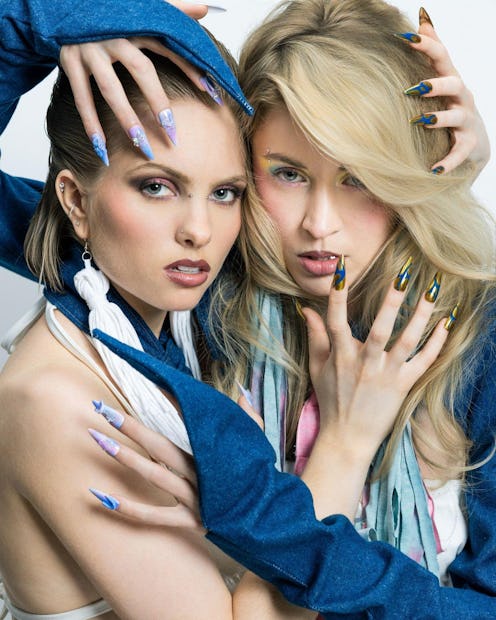Beauty
Nailed It: How Manicures Went From Red Carpet To Everyday Essential
Nails have gone from background detail to fashion essential, and now, they’re the final word in storytelling.

Once upon a time, a manicure was reserved for movie stars, runway models, and the rarefied world of red carpets. Today? It’s on everyone’s schedule, from 9-to-5 professionals to off-duty superstars. What used to be a luxury is now a non-negotiable. The question isn’t should you get your nails done, but how soon can you squeeze in your next appointment?
But nails are more than just polish and cuticle oil. They’re culture. They're storytelling. And they’ve got history.
Anna Sosina, a champion nail artist with an international résumé, shared how nails evolved from a background detail to a full-blown fashion statement and why no photo shoot or runway look is complete without a carefully curated set.
“Today, a manicure has become a pleasant routine, scheduled into our calendars. Every woman wants to feel her best, and a manicure is the finishing touch that completes the image.”
Nail History 101
The nail industry began taking shape in the 1920s, when the rise of Hollywood glamor and fashion photography popularized red nail polish. In black-and-white cinema, nails weren’t visible, but in color posters and photos, red polish made hands look more feminine and visually striking. Nail polish was brought to mass production. During those years, red was the dominant shade, and experimentation with darker tones began.
To bring a fresh take to nail trends, the moon manicure gained popularity between 1925–1940. This style involved painting only the center of the nail while leaving the lunula and the tip unpainted. Interestingly, this design made a comeback in 2015. It emphasized natural beauty and gave hands an elegant appearance.
In the 1950s, red polish and almond-shaped nails became iconic. No beauty icon would go without them.
A major turning point came in 1957 when acrylic nails were invented. This revolutionary step completely redefined what manicure could be and laid the foundation for today’s nail industry.
The French manicure was created in 1975. Due to frequent costume and image changes, a versatile nail style was needed, something that wouldn’t take much time. That’s when dedicated nail teams began appearing on film sets.
In the 2000s, pop culture brought a new wave of influence, introducing rhinestones, glitter, chains, and longer nails to the industry. This was the beginning of widespread experimentation with nail design. Artists sought to stand out by using 3D elements and long-lasting finishes.
From Background Detail To Center Stage
Nowadays, nails are not just part of a beauty routine. They’re part of the storyline. Celebs and their glam teams now build entire looks around nail art.
“Photographers frame shots with the hands in focus,” explains Anna. “In film, nails speak volumes about a character — their shape, color, and condition can convey mood, power, or vulnerability. More recently, television and fashion have embraced intricate nail styling, using it as a form of visual storytelling that mirrors personality and emotional depth.”
The Nail Stylist Is Now Non-Negotiable
Behind every glossy editorial spread, there’s a team — hair, makeup, wardrobe…and now, nails. Nail stylists are taking their rightful place in the glam squad lineup.
At major fashion weeks, brands now book nail artists in advance and match nail colors to runway palettes.
“At every shoot now, I’m involved from the beginning,” says Anna. “The nails are either the exclamation point or the foundation of the entire concept.”
A Model’s Secret Weapon? Good Nails. Always.
Jack Mayer, a model, shared her perspective on the importance of nails in photo shoots
“As a model, I know how important hands are in the frame. I’m often holding accessories, touching my face, or moving — and the manicure becomes part of the image. There’s no time for last-minute fixes: shoots move fast, and looks can change every hour. I can’t afford to worry about how my nails look. When there’s a professional nail stylist on set, it’s one less thing to worry about.”
And how do those nails actually get camera-ready?
Award-winning nail artist and international trainer Yuliia Kovalchuk weighed in on how nails get camera-ready.
“These days, nail prep usually happens right on set,” she explains.
She’s quick to point out that even the best glam lineup can fall flat if one thing is off.
“A manicure completes the overall look. A model may have perfect makeup, hair, and styling — but if the hands are not groomed, it immediately draws attention and can ruin the shot. Even with a strong creative team and a great photographer, poorly done nails can undermine the whole result.”
As for her role? It’s less about polish, more about precision.
“As a nail stylist, I complete the visual composition by selecting a manicure that matches the model’s image and the shoot’s concept. That way, the stylist, photographer, and art director can fully express their ideas.”
And when the camera’s rolling, she stays close.
“Whether it’s a close-up, a hand in frame, or a wide shot — the hands must look flawless. That’s why I always stay on set: I tailor manicures to each outfit and make sure everything stays perfect between takes. The wrong nail shape or color can break the entire visual harmony. My job is to make sure every shot is seamless.”
Let’s Be Real: Nails Are the Moment
Nails aren’t just an accessory. They’re a language. They communicate style, emotion, identity. And they’ve earned their place in fashion history.
From the red lacquer of the 1920s to the nail-art masterpieces of today, one thing is clear: manicures have become more than maintenance. They’re a form of expression. And in the worlds of fashion, film, and beauty, they’re here to stay.
BDG Media newsroom and editorial staff were not involved in the creation of this content.